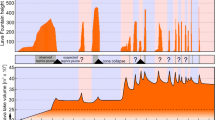Abstract
Ignimbrite morphology, previously generalised using aspect ratios, is here quantified as the relationships between the various thicknesses of material forming an ignimbrite and the areas and volumes represented by those thicknesses. The morphology can be measured for the deposit in its present-day, eroded condition, or reconstructed for the original deposit. The reconstructed morphology of the 22 500 year BP, ca. 11 500 km2, ca. 300 km3 Oruanui ignimbrite in New Zealand is documented to illustrate the latter approach. The Oruanui ignimbrite is an intermediate aspect ratio deposit and shows broadly linear relationships between (1) In thickness and the cumulative area occupied by that thickness or less of material and (2) thickness and the volume represented by that thickness or less of material. Two theoretical morphologies, one where thicknesses exponentially decay with distance from a maximum and the other of uniform thickness (“slab”), are compared with the Oruanui data. Limited comparative data suggest that low aspect ratio (violently emplaced) ignimbrites will show upward-concave curves (at one extreme following the “exponential decay” model) and high aspect ratio (gently emplaced) ignimbrites downward-concave curves (with the “slab” model as an extreme) when plotted on diagrams where the Oruanui data show linear trends. The effects of erosion on Oruanui and model ignimbrite morphologies are modelled using two theoretical erosion scenarios: (1) material is evenly removed from the land surface, and (2) thinner, non-welded material is preferentially removed. For the Oruanui ignimbrite data, area is lost much more rapidly in the first instance than volume; for example, 5 m of erosion is sufficient to remove 50 area %, whereas 40 m (scenario 1) or 120 m (scenario 2) of erosion is required to remove 50 volume %. In old ignimbrites, volume estimates may be reasonably accurate even after strong erosion, provided the original thicknesses of ponded/landscape-forming material can be inferred, but estimates of original area and aspect ratio will be inaccurate. An envelope enclosing all known outcrops of an ignimbrite will give a better estimate of original area and aspect ratio than simply summing the areas of known outcrops.
Similar content being viewed by others
References
Freundt A, Schmincke H-U (1986) Emplacement of small-volume pyroclastic flows at Laacher See (east-Eifel, Germany). Bull Volcanol 48:39–59
Froggatt PC (1982) Review of methods of estimating rhyolitic tephra volumes: applications to the Taupo volcanic zone. J Volcanol Geotherm Res 14:301–318
Hildreth W (1987) New perspectives on the eruption of 1912 in the Valley of Ten Thousand Smokes, Katmai National Park, Alaska. Bull Volcanol 49:680–693
Lipman PW (1975) Evolution of the Platoro caldera complex and related volcanic rocks, southeastern San Juan Mountains, Colorado. US Geol Surv Prof. Pap 852:1–128
Malin MC, Sheridan MF (1982) Computer assisted mapping of pyroclastic surges. Science 217:637–640
Northey DJ (1983) Seismic studies of the structure beneath Lake Taupo. PhD thesis, Victoria University of Wellington, New Zealand
Pyle DM (1989) The thickness, volume and grainsize of tephra fall deposits. Bull Volcanol 51:1–15
Self S (1983) Large-scale phreatomagmatic silicic volcanism: a case study from New Zealand. J Volcanol Geotherm Res 17:433–469
Self S, Healy J (1987) Wairakei Formation, New Zealand: stratigraphy and correlation. NZ J Geol Geophys 30:73–86
Suzuki-Kamata K, Kamata H (1990) The proximal facies of the Tosu pyroclastic-flow deposit erupted from Aso caldera, Japan. Bull Volcanol 52:325–333
Ui T (1983) Exceptionally far-reaching, thin pyroclastic flow in southern Kyushu, Japan. Bull Volcanol Soc Japan, 2nd Ser. 18:153–168 (in Japanese with English abstract)
Walker GPL (1973) Explosive volcanic eruptions — a new classification scheme. Geol Rundsch 62:431–446
Walker GPL, Heming RF, Wilson CJN (1980) Low-aspect ratio ignimbrites. Nature 283:286–287
Walker GPL, Wilson CJN, Froggatt PC (1981) An ignimbrite veneer deposit: the trail marker of a pyroclastic flow. J Volcanol Geotherm Res 9:409–421
Wilson CJN (1985) The Taupo eruption, New Zealand. II. The Taupo ignimbrite. Phil Trans R Soc Lond A 314:229–310
Wilson CJN, Walker GPL (1981) Violence in pyroclastic flow eruptions. In: SSelf and RSJ Sparks (eds) Tephra studies. D Reidel, Dordrecht: 441–448
Wilson CJN, Houghton BF, Lloyd EF (1986) Volcanic history and evolution of the Maroa-Taupo area, central North Island. Bull R Soc New Zealand 23:194–223
Wilson L, Head JW (1981) Morphology and rheology of pyroclastic flows and their deposits, and guidelines for future observations. US Geol Surv Prof Pap 1250:513–524
Yokoyama S (1974) Mode of movement and emplacement of Ito pyroclastic flow from Aira caldera. Sci Rept Tokyo Kyoiku Daigaku, Sec C. 12:17–62
Author information
Authors and Affiliations
Rights and permissions
About this article
Cite this article
Wilson, C. Ignimbrite morphology and the effects of erosion: a New Zealand case study. Bull Volcanol 53, 635–644 (1991). https://doi.org/10.1007/BF00493690
Received:
Accepted:
Issue Date:
DOI: https://doi.org/10.1007/BF00493690




